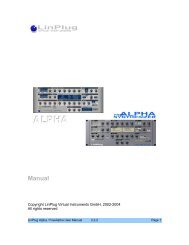CrX4 User Manual - LinPlug Virtual Instruments
CrX4 User Manual - LinPlug Virtual Instruments
CrX4 User Manual - LinPlug Virtual Instruments
You also want an ePaper? Increase the reach of your titles
YUMPU automatically turns print PDFs into web optimized ePapers that Google loves.
equired for microtuning a wide range of hardware and software<br />
synthesizers and samplers.<br />
Scala may also be used to create the TUN format microtuning files needed<br />
to explore microtunings with this software instrument. The Scala home<br />
page is at: http://www.huygens-fokker.org/scala/<br />
Specifying the Reference Frequency of a Microtuning<br />
One of the powerful capabilities of the TUN format and Scala is the ability<br />
to specify the frequency and MIDI-note number for the pitch base of a<br />
microtuning. This becomes a very important consideration when one is<br />
using a number of different synthesizers and wishes to keep them in all<br />
tune with a given base frequency.<br />
It is a common requirement for musicians and composers to be able to<br />
specify concert pitches such as A440 Hz (MIDI-Note 69) or C261.6256 Hz<br />
(MIDI-Note 60) as a reference pitch for a microtuning, however, the<br />
flexibility of the TUN format enables one to specify this frequency arbitrarily,<br />
so that any base frequency may be assigned to any MIDI-note number. In<br />
Scala this important parameter is called the Reference Frequency.<br />
Being able to specify a particular MIDI-note number on the MIDI controller<br />
and its associated Reference Frequency, provides a way to map a<br />
microtuning to a common base pitch, making it easier to navigate the<br />
instrument when the intonation system may have more or less than 12<br />
tones per octave, or where one may need to map the notes of a<br />
microtuning to fall on certain physical keys.<br />
Important Note<br />
When musicians use TUN microtuning files with this software instrument,<br />
the above mentioned mapping properties will override the Master Tune<br />
setting, which is set to a default of 440 Hz (found on the Setup page).<br />
Normally when one is using the default 12 Tone Equal Temperament<br />
tuning, the Master Tune setting can be used to set pitch offsets around the<br />
standard concert pitch of A440 Hz, however, when one has specified<br />
another pitch base for a microtuning when creating TUN files in Scala,<br />
these settings will determine the actual Reference Pitch for the intonation<br />
system being used.<br />
<strong>CrX4</strong> <strong>User</strong> <strong>Manual</strong> 70












